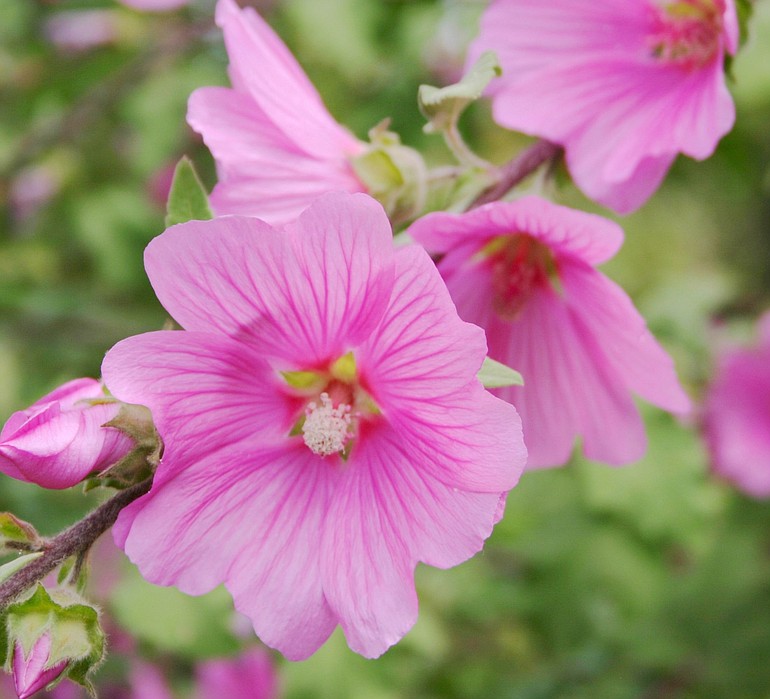Every year in mid- to late spring, there is a moment when I find myself standing out in the garden, amazed by it all. The round, plump peony buds open into flowers larger than my open hand. The dogwoods bloom as if by magic from bare branches. Bird-song adds another dimension to the garden, as a musical score brings a Broadway show to life.
All of a sudden, the once-dormant lawn demands regular mowing. Even though I have already weeded beds and borders, new weeds are back and ready to set seed. The rhododendron is in full bloom one day and needs to have its sticky, spent flower heads removed the next. At this time of year, one garden chore leads to another.
As the flowers fade, fertilize your spring-blooming trees and shrubs. This will signal young plants to begin the production of next year’s flowers. Broad-leaved evergreens such as rhododendron and camellia require acidic soil conditions, so be sure to choose the appropriate fertilizer. As trees and shrubs mature, you can cut back on fertilization. Large, established plants can usually get the nutrients they need from our soil without additional feeding.
As early spring bulbs come to the end of their show, let them be a reminder to plant summer-blooming bulbs, corms and tubers. Prepare anemones, gloxinias, cannas and calla lilies for planting out in the garden or into large pots. Bring tender dahlias and begonias out of storage if you packed them away for winter. Gladiolas are also ready to go out in the garden at this time.
As a guide to planting depth, bury most late-season bulbs twice as deep as the bulb’s length. If the bulb is one-inch long, cover it with two inches of soil. If your tubers are dry and shriveled after their long storage, you can plump them up by soaking in water for a day before you plant them. Divide large clusters of dahlias before they go into the ground to increase your number of plants or to share with fellow gardeners.
By now, the soil has had a chance to warm up. Most shrubs and perennials have filled out enough for you to see any gaps in beds and borders. To minimize transplanting shock, protect plants from extreme heat and strong sunlight, planting on an overcast day or in the evening. Although we are not thrilled with misty weather once we have had a few hot, sunny spring days, it could be the best thing to happen to newly planted seedlings.
This is also the perfect time to add annuals or perennials to a bulb bed. The stems of the bulb are still showing above ground, so you can clearly see where it is safe to plant without damaging the bulb. Use plants that leaf out early, especially plants with foliage tall enough to cover the spent bulbs. Daylilies are ideal for full sun.
While you are out in the garden beds, put wire plant grids and other supports into place so perennials can grow up through them. One of the easiest stakes to use is the flexible “Y” stake. The support portion of the stake is a very sturdy, hollow metal tube with a pointed end that pushes easily into the soil. Two flexible arms wrap around a plant as loosely or as firmly as you choose. Let the arms hold up the interior body of the plant, allowing a few of the stems and flowers to stand freely outside the confines of the stake.
Fertilize bulbs as the flowers fade and begin to deadhead early-blooming perennials. Pinch back fall-flowering chrysanthemums, garden phlox and asters so they grow more compact and bushier before blooming in late summer.
The gardener’s hand
It’s a good thing the days are longer or we’d never have time for every spring chore. In May, a gardener’s work is never done, which is fine by me.
It is the nature of things to grow and flower, but I like to remind my friends to take credit for their creative input. Relish the details that work especially well in your own garden.
It was my idea to plant my ‘Johnson’s Blue’ geranium and the golden ‘Stella D’Oro’ daylily together and the combination is delightful. The hummingbirds rely on me to fill the feeders that draw them to the garden and I rely on the hummingbirds for the sheer enchantment of their presence.
Robb Rosser is a WSU-certified Master Gardener. Reach him at Write2Robb@aol.com.



